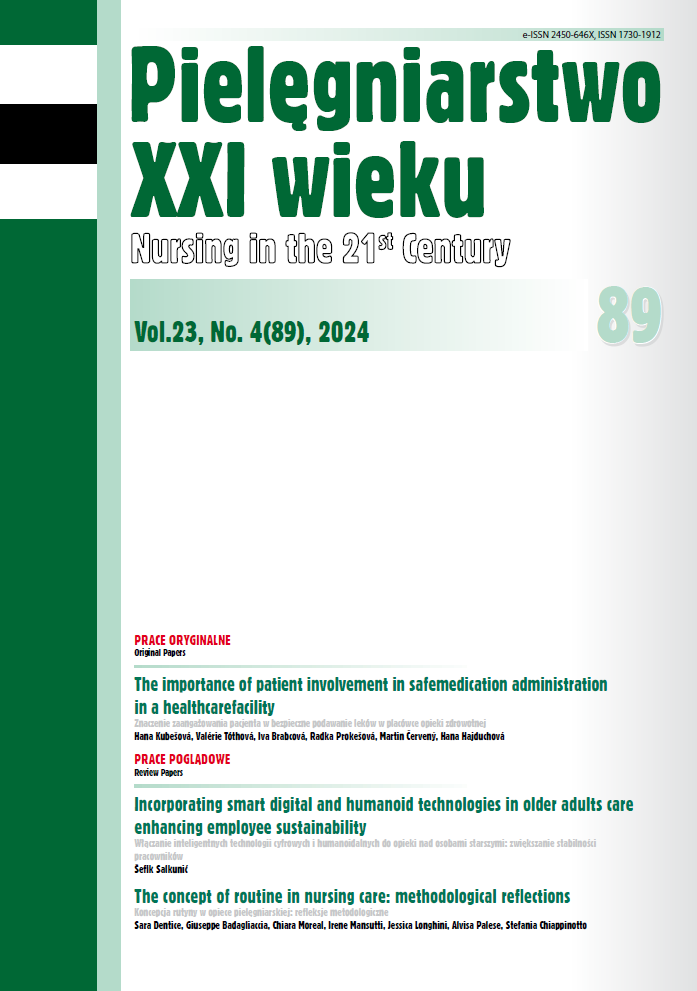Incorporating smart digital and humanoid technologies in older adults care enhancing employee sustainability
DOI:
https://doi.org/10.2478/pielxxiw-2024-0042Keywords:
robots, digital technologies, working ability, institutional care of the elderly adultsAbstract
INCORPORATING SMART DIGITAL AND HUMANOID TECHNOLOGIES IN OLDER ADULTS CARE ENHANCING EMPLOYEE SUSTAINABILITY
Aim. This article investigates the potential impact of integrating DT and robots in ICE. By reducing absenteeism, supporting new employees, and improving job satisfaction among caregivers, we aim to highlight the significant benefits these technologies can bring to the workforce in the older adult care sector.
Material and methods. An integrative literature review was conducted following PRISMA guidelines, with searches in databases like Web of Science, PubMed, and COBISS using specific keywords related to DT and robots in ICE. Relevant articles were selected based on inclusion and exclusion criteria.
Results. The review identified 48 relevant articles, with 7 meeting inclusion criteria. Findings suggest that integrating DT and robots in ICE can improve job satisfaction, support learning and skill development, and enhance organizational support for caregivers.
Conclusions. Research indicates that digital technologies and robots can significantly impact work ability, yet much remains to be explored. Their integration holds potential to reduce absenteeism and boost job satisfaction, but it also brings challenges such as justifying investments and addressing staff concerns. Understanding their effects on employee health is essential, and further research is needed on multicultural team dynamics and public health system sustainability. Studying implementation challenges, especially in developing countries, is an ongoing process that requires continued investigation.
References
1. Eurostat. Long-term care beds in nursing and residential care facilities. 2020.
2. Spasova S, Baeten R, Vanhercke B. Challenges in Long-term Care in Europe. Eurohealth. 2018; 24: 7-12.
3. Utharman TC. Older nurses: A literature review on challenges, factors in early retirement and workforce retention. Proc. Singapore Healthc. 2016; 25(1): 50-55.
4. Köllner W. Psychisch krank in der Pflege - Psychische Belastungen durch dem Beruf, Möglichkeiten zu Prävention und Rehabilitation. Bonn: Friedrich - Ebner - Stifftung. Abteilung Wirtschafts - und Sozialpolitik; 2015.
5. Gröning W, Kromar K, Konrad N. Älter werden im Pflegeberuf. [cited February 2018]. Available from: https://www.bgw-online.de/SharedDocs/Downloads/DE/Medientypen/BGW%20Broschueren/BGW04-09-012_Aelter-werden-im-Pflegeberuf_Download.pdf?__blob=publicationFile.
6. Prakash KC, et al. Intention to retire in Employees over 50 years. What is the Role of Work ability and Work Life Satisfaction. Int. J. Environ. Res. Public Health. 2019; 16(14): 2500.
7. Ilmarinen J. New dimensions of workability. Scand. J. Work Environ. Health. 2005; 1280: 3-7.
8. Ilmarinen J. From work Ability Research to Implementation. Int. J. Environ. Res. Public Health. 2019; 16(16): 2882.
9. Standeker N. Factors Affecting Work Ability Among Employees in Institutional Care of the Elderly across Austria Croatia and Slovenia. Good Quality of Old Age: Journal for Gerontology and Intergenerational Relations. 2021; 24(1): 31-41.
10. Page J, McKenzie J, Bossuyt P. The PRISMA 2020 statement: an update guideline for reporting systematic reviews. Syst. Rev. 2021; 10:89. Available from: https://doi.org/10.1186/s13643-021-01626-4.
11. Huisman C, Kort H. Two-Year Use of Care Robot Zora in Dutch Nursing Homes: An Evaluation Study. Healthcare. 2019; 7(1): 31.
12. Zhao Y, Rakhani ZF, Schariff-Gazali S, et al. Defining the concepts of a smart nursing home and its potential technology utilities that integrate medical services and are acceptable to stakeholders: a scoping review. BMC Geriatr. 2022; 22(1): 787.
13. Zamiri M, Sarraipa J, Luis-Ferreira F, et al. Review of technology-supported multimodal solutions for people with dementia. Sensors (Basel). 2021; 14: 4806.
14. Jadan L, Gill TK, Taylor A, et al. Identifying opportunities, and motivation to enhance capabilities, influencing the development of a personalized digital health hub model of care for hip fractures: mixed methods exploratory study. J. Med. Internet. Res. 2021; 23(10): e26886. vAvailable from: https://www.ncbi.nlm.nih.gov/pmc/articles/PMC8587193/.
15. Alexander GL, Georgiou A, Doughtry K, et al. Advancing health information technology roadmaps in long term care. Int. J. Med. Inform. 2020; 136:104088. Available from: https://doi.org/10.1016/j.ijmedinf.2020.104088.
16. Casey D, Barett G, Kovacic T, et al. The perceptions of people with dementia and key. Int. J. Environ. Res. Public Health. 2020; 17(22):8621. Available from: https://doi.org/10.3390/ijerph17228621.
17. Krick T, Huter K, Domhoff D, et al. Digital technology and nursing care: a scoping review on acceptance, effectiveness and efficiency studies of informal and formal care technologies. BMC Health Serv. Res. 2019. Available from: https://bmchealthservres.biomedcentral.com/articles/10.1186/s12913-019-4238-3.
18. Melkas H, Henalla L, Pekkarinen S, et al. Impacts of robot implementation on care personnel and clients in elderly-care institutions. Int. J. Med. Inform. 2020; 134: 104041.
19. Coco K, Kangasnieni M, Rantanen T. Care personnel’s attitudes and fears toward care robots in elderly care: a comparison of data from the care personnel in Finland and Japan. J. Nurs. Sch. 2018; 50(6): 634-644.
20. Papadopoulos I, Kouliuglioti C, Ali S. Views of nurses and other health and social care workers on the use of assistive humanoid and animal-like robots in health and social care: a scoping review. Contemp. Nurse. 2018; 54(4-5): 425-442.
21. Fosen F, Sorgner A. Mapping the future of occupations: transformative and destructive effects of new digital technologies on jobs. Foresight. 2019; 13(2): 10-18.
22. Nübler I. New technologies: a jobless future or golden age of job creation? Int. Labour Office Res. Dept. Working Paper. 2016; 13(22-23).
23. Yadav SR. Robotics in Nursing. [cited November 2022]. Available from: https://www.linkedin.com/pulse/robotics-nursing-dr-shruti-yadav.
24. Bryndal A, Glowinski S, Grochulska A. Influence of Occupation on the Prevalence of Spinal Pain among Physiotherapists and Nurses. J. Clin. Med. 2022; 11(19):5600.
25. National Academies of Sciences, Engineering, and Medicine. The future of nursing 2020–2030: Charting a path to achieve health equity. Washington, DC: The National Academies Press; 2021. Available from: https://doi.org/10.17226/25982.
Downloads
Published
Issue
Section
License
Copyright (c) 2024 Authors

This work is licensed under a Creative Commons Attribution 4.0 International License.




